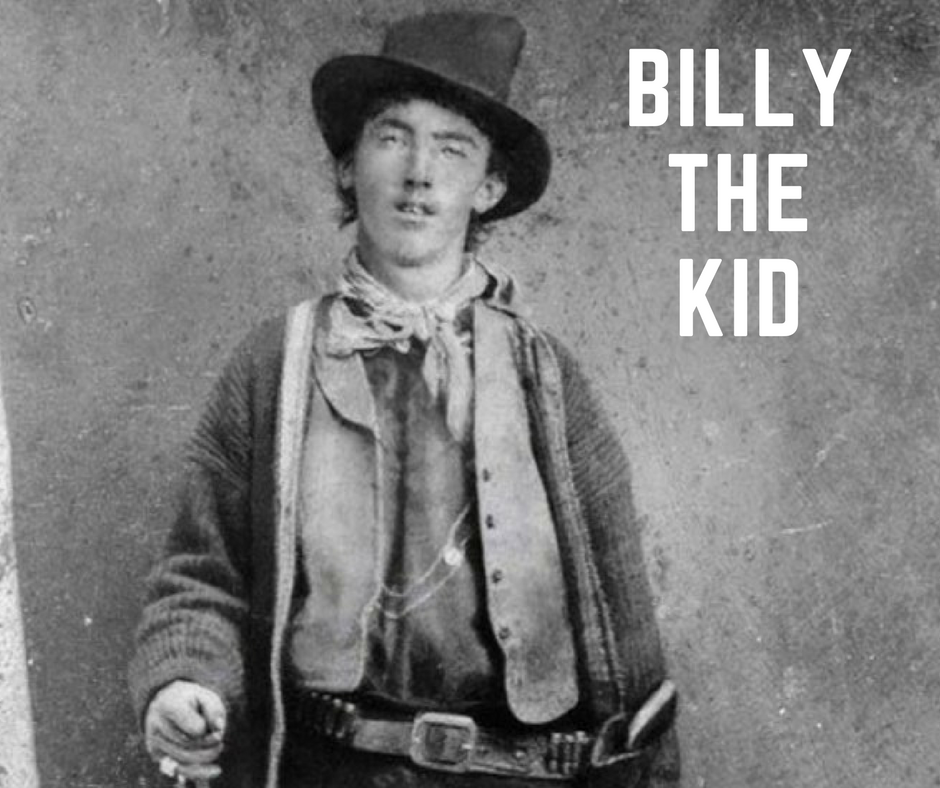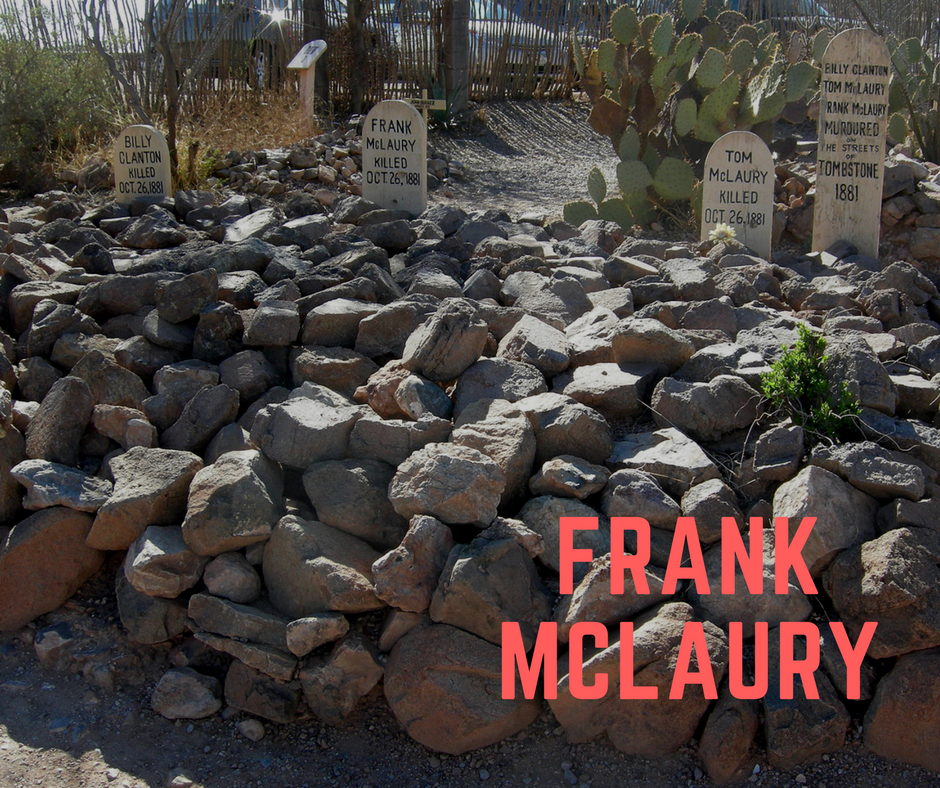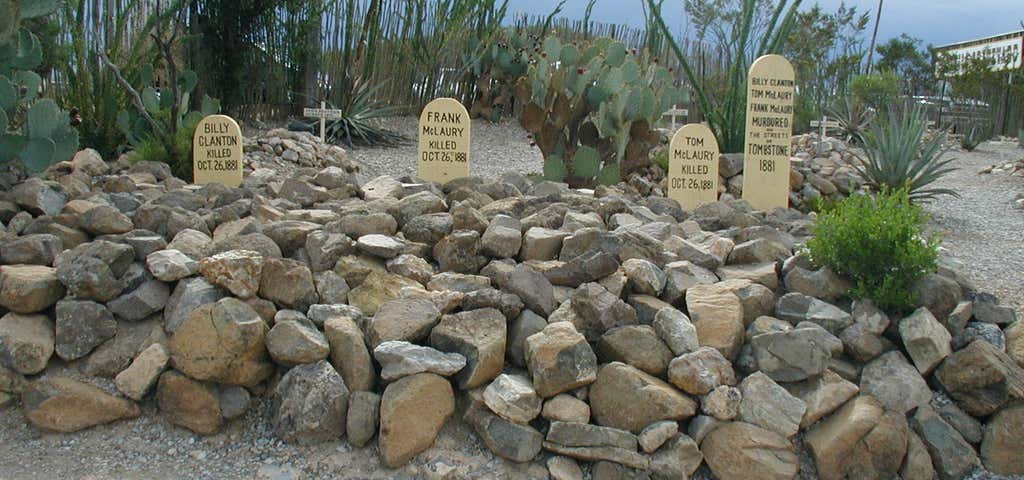Outlaws and criminals have fascinated the American public for decades-- even in death, they're still talked about and in some cases, remembered almost fondly. Believe it or not, some famed outlaws' graves get more visitors than the graves of some Presidents and other American heroes. Sure, it could be because they frequently died violent (and occasionally mysterious) deaths, but it's also chilling to think that they were (for the most part, at least) ordinary people who turned to crime out of necessity. Visit these famous outlaws' graves to get the full backstory on some of America's most dangerous and most wanted.


Billy the Kid began his killing career at the tender age of 16... and a mere 5 years later, this Wild West outlaw had become one of the West's most famous fugitives. That reputation made him more than a few enemies. He was only 21 when he was (allegedly) killed by Sheriff Pat Garrett. Since it was the Wild West, though, accounts of his death are murky, and more than one man has come forward claiming to be Billy the Kid in the flesh-- although there's virtually no way to even get DNA for a test to prove or refute these claims. You can find what most accept to be the grave of Billy the Kid at the Old Fort Sumner Museum. You can't miss it-- it's the gravestone that's behind bars. Billy the Kid’s headstone has been stolen not once, but twice. (Some accounts mention 3 times, but this has proven difficult to verify. The grave was, however, knocked over and vandalized in the 2000s.)
Billy the Kid’s tombstone was first stolen in 1950 by parties unknown and remained missing until a couple from Texas visited Fort Sumner in 1975 and mentioned when they sold their house in 1969 the new owner found a headstone partially buried on the property. The Branhams, the couple from Texas, and the home’s new owner, Gaylan Wright, gave the stone back to Fort Sumner for replacement at Billy’s “grave.” Billy the Kid’s tombstone remained unharmed for 6 years before being stolen once again in 1981, only to be recovered a week later in Huntington Beach, CA.


Western Heights Cemetery
This unlikely duo's crime spree earned them fame as the most notorious members of a Great Depression-era gang. Bonnie Parker and Clyde Barrow met in the slums outside Dallas and robbed banks and stores across the South... killing several lawmen and civilians along the way. Of course, the pair was doomed to meet a nasty end, but they went out in a blaze of glory when they were ambushed on a rural road in Louisiana and six sheriffs emptied their guns into their car. Their deaths caused a media frenzy, and both funerals attracted hoardes of people hoping to catch a glimpse of the caskets. Many also sent flowers-- the largest bouquet came from a group of newsboys, since the duo's deaths had sold 500,000 papers in Dallas alone. Clyde was buried next to his brother at Western Heights Cemetery on May 25th.
Crown Hill Memorial Park
Bonnie's wish was to be buried alongside her parter-in-crime, but sadly, that never happened. Her family disregarded her request entirely and had her laid to rest at Crown Hill Memorial Park in Dallas. You can also visit the Bonnie & Clyde Ambush/Death Site Memorial, where law enforcement finally brought the famed Public Enemies down, and Bonnie and Clyde's Death Car, still riddled with bloodstains and bullet holes.


Frank McLaury was a cowboy and cattle rancher in the town of Tombstone, Arizona... yep, you can see where this is going; he was one of the men killed in the famous gunfight at the O.K. Corral. Frank, his brother Tom, and their friends Ike and Billy Clanton and Billy Claiborne had been feuding with Tombstone's sheriff, Wyatt Earp, his brothers, and his friend Doc Holliday-- Earp belived that the McLaurys had been stealing horses and cattle, and when he heard that they were in town with their gang of cowboys, a shootout ensued. Frank, Tom, and Billy Clanton were all killed in the gunfight. You can see their graves at Tombstone's Boot Hill Graveyard-- so named because many outlaws who died violent deaths (or, as they said back in the day, "died with their boots on") are buried there.


Mount Olivet Cemetery - Kansas City
Probably one of the most famous outlaws in all of American history, Jesse James was known for leading the James-Younger gang, which robbed banks and held up trains like it was their job. Despite being tracked by the Pinkerton Detective Agency as well as numerous town lawmen, James's death was surprisingly anticlimactic: He was dusting off a needlepoint in his home when he was shot by a backstabbing member of his own gang, Bob Ford, who was out to collect the bounty on James. He's buried at Mount Olivet Cemetery, although he was buried for some time at the farm where he grew up.
Jesse James Farm and Museum
The epitaph his mother wrote for his original gravesite pretty legendary (you can still see it at the Jesse James Farm and Museum today): "In Loving Memory of my Beloved Son, Murdered by a Traitor and Coward Whose Name is not Worthy to Appear Here." She also reportedly moved her bed to a position that allowed her to always keep an eye on his grave... just in case.


Frank Reno was the head of the deadly Reno gang, which terrorized the Midwest. In fact, they were quite possibly the first "brotherhood of outlaws" in America, having banded together around 1864. The Reno gang pioneered the concept of the train robbery, but they didn't enjoy the public support lavished on the James-Younger gang, another outlaw band fond of holding up trains. The James-Younge gang had a reputation for being almost Robin Hood-esque, whereas the Reno gang was pretty widely feared... in fact, most of the Reno gang's members were lynched while under arrest, before they could even go to trial. Frank managed to evade capture the longest, escaping to Canada before being caught and extradited back to America, where he and the remaining members were almost immediately kidnapped from their cells and hanged. The controversial outlaw is buried in a fenced off grave at Indiana's Old Seymour City Cemetery.


Akins Cemetery
The funeral for famed Depression-era criminal outlaw Pretty Boy Floyd remains the biggest, most widely-attended in Oklahoma history. The reason Charles Arthur "Pretty Boy" Floyd was so popular? When he would rob a bank, he'd also make a point to destroy mortgage documents, freeing many citizens of their debts. Also, his boyish good looks and tragic tale of turning to a life of crime in a time when many were impoverished and willing to do anything to get by didn't hurt. He was killed while fleeing police after they tracked him down to a cornfield in Ohio. You can visit his grave and pay tribute to the Robin Hood of the Great Depression-- he's buried at Akins Cemetery in Oklahoma.


One of the West's most famous female outlaws died a mysterious and equally legendary death. Belle Starr was close with members of Jesse James's gang when she was younger, and two of her husbands were also well-known outlaws. She spent most of her time organizing and harboring gangs of bootleggers and cattle rustlers, and garnered a few arrest warrants of her own. She spent some time in prison, but things got really rough for her once her second husband, Sam Starr, was killed. No one is even sure how or when Belle was killed-- some reports say she was ambushed and killed with her own double barrell shotgun while riding home, others say a man named Edgar Watson murdered her after she turned him down at a dance as she was headed back to her house, and still others suspect her third husband, her son, or one of her sharecroppers. Whichever way it went down, her death has become famed as an unsolved mystery... but at least you can visit her grave at the Belle Starr Cabin.


Crown Hill Cemetery
It was always big news when a famous outlaw was finally brought down, but the death of John Dillinger caused what was quite possibly the biggest uproar. Dillinger's rap sheet boasted 24 bank robberies (!), four police station robberies (!!), two successful jail breaks (!!!), and one count of murdering a police officer. His bold holdups (seriously, robbing one police station is ballsy, but four? Jeez.) and his charisma made him a staple on the front pages of newspapers in and around Illinois, Iowa, and South Dakota where he mostly operated. He was set up by the owner of the brothel where he was staying and was shot outside a Chicago movie theater. His wake and funeral attracted thousands, and his grave at Crown Hill Cemetery still brings in curious visitors to this day. But there's more to the grave than meets the eye.
Right after Dillinger's widely-attended burial, the cemetery placed a 24-hour watch detail on his grave for fear of his gang coming back to take his body or, more likely, the general public destroying the site. Dillinger’s father became increasingly fearful the plot would be tampered with. He had the cemetery dig up John’s wooden casket and then had it reburied with 4 giant concrete slabs, each reinforced with metal, at different depths. Anyone looking to dig up John’s body would face not 1, but 4 layers of metal and concrete.
While most believe this was done to protect John’s body, other believe it was to ensure no one every tried to exhume the body (if there was a body). Conspiracists think John Dillinger’s father had the grave protected to protect the truth: his son was alive and well, having tricked the FBI into killing the wrong man. We know... this is a little far-fetched.
Truth be told, John Dillinger’s dad probably knew from seeing how the crowds reacted during the burial that the gravesite was likely to be tampered with. Since John’s burial, his headstone has been replaced 4 times due to people chipping off pieces of it as souvenirs. Rather than do that, you can leave a penny on the grave for good luck.
Roadtrippers
Roadtrippers helps you find the most epic destinations and detours—from roadside attractions to natural wonders and beyond.
Explore More Trip Guides
Soak up the sun with a road trip along the Indiana Dunes
- 11 Places
- 02:44
- 97 mi












